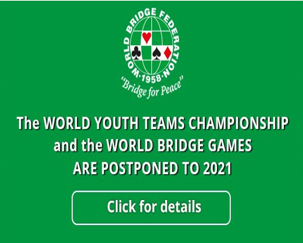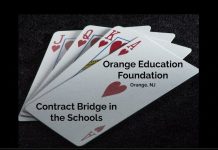
- Is easy to remember
- Focuses on high-frequency gains, doesn’t worry about low-frequency scenarios
- Doesn’t rely on the opponents passing.
While working with my partner Nye last year to improve our system before we went overseas, we attempted to make our system as practical as possible. The emphasis was on creating rules to cover wide varieties of situations. The rules weren’t necessarily optimal, but they were hard to forget and got the job done for the most part.
This process involves going through what you already play and asking yourself some questions:
- Which parts have we had disasters with, or have forgotten, or might forget?
- Which parts win IMPs frequently, and which parts don’t seem to come up at all?
- Which parts of our system are vulnerable to interference, and what can we do about that? Are there some rules we can have to cover multiple situations?
 (2
(2 ) ?
Does your partnership have a firm, written agreement about what double means? What about 2
) ?
Does your partnership have a firm, written agreement about what double means? What about 2 – does this suggest five or just four? What about responder’s double?
It doesn’t matter too much what you play, as long as it is consistent, easy to remember and will do an OK job when it comes up. For what it’s worth, I play double is penalty, either side.
If there are so many questions about such a simple auction, we can extend this sort of examination to more complicated parts of our system…
Jacoby 2NT example:
1
– does this suggest five or just four? What about responder’s double?
It doesn’t matter too much what you play, as long as it is consistent, easy to remember and will do an OK job when it comes up. For what it’s worth, I play double is penalty, either side.
If there are so many questions about such a simple auction, we can extend this sort of examination to more complicated parts of our system…
Jacoby 2NT example:
1 (P) 2NT (3
(P) 2NT (3 ) ?
1
) ?
1 (P) 2NT (4
(P) 2NT (4 ) ?
What does your partnership do in these two situations? What is double, and what is pass? How about bidding a new suit?
Instead of coming up with something yourself, you can simply ask a top player (the best you can find!) what they do. Here’s what my notes with Nye say about this situation: “If they overcall after 1M-2NT Jacoby, double is penalties. Pass is forcing without shortage in their suit, and bids are cues with shortage in their suit by opener. By responder bids are cues (no desire to penalise).” Short, easy to remember, and very effective (knowing when opener has shortage is crucial to bidding slams or competing to the 5-level). This was copied almost verbatim from a top European partnership who we asked about this situation.
Another simple situation with natural bidding:
1
) ?
What does your partnership do in these two situations? What is double, and what is pass? How about bidding a new suit?
Instead of coming up with something yourself, you can simply ask a top player (the best you can find!) what they do. Here’s what my notes with Nye say about this situation: “If they overcall after 1M-2NT Jacoby, double is penalties. Pass is forcing without shortage in their suit, and bids are cues with shortage in their suit by opener. By responder bids are cues (no desire to penalise).” Short, easy to remember, and very effective (knowing when opener has shortage is crucial to bidding slams or competing to the 5-level). This was copied almost verbatim from a top European partnership who we asked about this situation.
Another simple situation with natural bidding:
1 (P) 1
(P) 1 (2
(2 ); Dbl (P) ?
1
); Dbl (P) ?
1 (P) 1
(P) 1 (2
(2 ); P (P) ?
Opener either makes a support double (or takeout double if you prefer), or passes… denying the double hand-type. What do responder’s bids mean now? How do you force, how do you get out low?
This is a VERY frequent situation where many pairs, even experts, do not seem to have explicit rules about how to move forward. Nye and I simply stole a rule from Andy Hung, which virtually guarantees that it will do the business:
They interfere after responder bids a suit: Support doubles and redoubles (next double takeout). New suits by responder NF (Cue bid, Dbl or Jump to force) – applies after opener passes OR doubles. Double and bid by responder is forcing to game.
Or if you want to go even deeper down the rabbit hole:
Bidding by the 1
); P (P) ?
Opener either makes a support double (or takeout double if you prefer), or passes… denying the double hand-type. What do responder’s bids mean now? How do you force, how do you get out low?
This is a VERY frequent situation where many pairs, even experts, do not seem to have explicit rules about how to move forward. Nye and I simply stole a rule from Andy Hung, which virtually guarantees that it will do the business:
They interfere after responder bids a suit: Support doubles and redoubles (next double takeout). New suits by responder NF (Cue bid, Dbl or Jump to force) – applies after opener passes OR doubles. Double and bid by responder is forcing to game.
Or if you want to go even deeper down the rabbit hole:
Bidding by the 1 opener after an overcall in the sandwich position: after opener bids 1
opener after an overcall in the sandwich position: after opener bids 1 and hears a 1X response and a 2-level overcall on his right, cue-bidding the opponent’s suit at the 3-level shows 6+
and hears a 1X response and a 2-level overcall on his right, cue-bidding the opponent’s suit at the 3-level shows 6+ , not 3 of partner’s suit (no support double), a maximum hand and no stopper in the opponents suit. Or even more extreme: Delayed cue bid: If opener passes over a sandwich overcall, then later cue-bids over responder’s takeout double, this is defined as “good hand, choice of strain, no clear direction”. It is not a slam try in responder’s presumed suit. Here’s an example of how it works in practice:
One of my personal favourite partnership hands was, in fact, this effort from near the end of the event. We faced Thailand in Match 11. RR2. Although our chances for a medal were quite low at this point, we still wanted to finish as high as possible, and we were running fifth while Thailand were sixth.
Dealer North. E/W Vul
, not 3 of partner’s suit (no support double), a maximum hand and no stopper in the opponents suit. Or even more extreme: Delayed cue bid: If opener passes over a sandwich overcall, then later cue-bids over responder’s takeout double, this is defined as “good hand, choice of strain, no clear direction”. It is not a slam try in responder’s presumed suit. Here’s an example of how it works in practice:
One of my personal favourite partnership hands was, in fact, this effort from near the end of the event. We faced Thailand in Match 11. RR2. Although our chances for a medal were quite low at this point, we still wanted to finish as high as possible, and we were running fifth while Thailand were sixth.
Dealer North. E/W Vul
I opened a Precision 1 K 10 9 7
K 10 9 7
 8
8
 A Q 9 6 4
A Q 9 6 4
 9 6 5
9 6 5 J 6 5 4 3
J 6 5 4 3
 5
5
 10 8 7
10 8 7
 K Q J 4
K Q J 4 Q
Q
 10 9 7 4
10 9 7 4
 J 3 2
J 3 2
 A 8 7 3 2
A 8 7 3 2 A 8 2
A 8 2
 A K Q J 6 3 2
A K Q J 6 3 2
 K 5
K 5
 10
10 as North, taking advantage of the favourable vulnerability to make a systemic ultra-light opening. Nye responded 1
as North, taking advantage of the favourable vulnerability to make a systemic ultra-light opening. Nye responded 1 , West overcalled 1
, West overcalled 1 and this was passed back to Nye in the South seat. One of the key pieces of preparation that Nye and I had done in the months leading up the event was to firm up our system notes; crucially, filling in the gaps in common competitive auctions.
In your partnership, what does 2
and this was passed back to Nye in the South seat. One of the key pieces of preparation that Nye and I had done in the months leading up the event was to firm up our system notes; crucially, filling in the gaps in common competitive auctions.
In your partnership, what does 2 mean in this auction? What about double, then 2
mean in this auction? What about double, then 2 or 3
or 3 over partner’s 2
over partner’s 2 bid? Or double and a new suit, or cuebing the opponent’s suit? What about if opener makes a support double instead of passing?
Because of our preparation. Nye and I had a clear agreement here: double and bid again by responder is forcing to game. Here. Nye could double and, over my 2
bid? Or double and a new suit, or cuebing the opponent’s suit? What about if opener makes a support double instead of passing?
Because of our preparation. Nye and I had a clear agreement here: double and bid again by responder is forcing to game. Here. Nye could double and, over my 2 bid, jump to 3
bid, jump to 3 . As 2
. As 2 would have been game-forcing, 3
would have been game-forcing, 3 must be suit-setting. Now I could cuebid 3
must be suit-setting. Now I could cuebid 3 (knowing Nye would not get carried away, having limited my hand), Nye bid 4
(knowing Nye would not get carried away, having limited my hand), Nye bid 4 . I bid 4
. I bid 4 and Nye could Key Card to the laydown slam. Over half the field missed this 26 point slam (including our opponents), so chalk one up to preparation!
In our view, this is where bidding swings tend to come from in the real world: a relatively frequent situation where one pair is on firm footing, and the other table is guessing… not what the fifth and sixth bids mean after Keycard!
Here are some tell-tale signs that your system isn’t as practical as it could be:
and Nye could Key Card to the laydown slam. Over half the field missed this 26 point slam (including our opponents), so chalk one up to preparation!
In our view, this is where bidding swings tend to come from in the real world: a relatively frequent situation where one pair is on firm footing, and the other table is guessing… not what the fifth and sixth bids mean after Keycard!
Here are some tell-tale signs that your system isn’t as practical as it could be:
- You have lots of agreements about how you bid when the opponents are passing throughout, but much fewer agreements about what to do when they interfere;
- You are constantly tinkering with small improvements to your constructive or slam bidding auctions, but haven’t discussed what doubles or 2NT bids in competition mean in quite a while;
- You have agreed to play a gadget, but your notes don’t say much about continuations or bidding in competition after the gadget gets used.
Don’t forget to follow us @

























